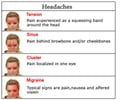Nearly 40 percent of kids and teens with migraine no longer had headaches 10 years later, and another 20 percent developed less severe headaches, according to a new study.
There’s good news for kids and teens with migraines. Nearly 40 percent of kids and teens with migraine no longer had headaches 10 years later, and another 20 percent developed less severe headaches, according to a new study published in the October 24, 2006, issue of Neurology, the scientific journal of the American Academy of Neurology.
Kids with a family member with migraines were most likely to still have migraines 10 years later.For the study, researchers screened all of the kids and teens age 11 to 14 in school in the town of Monreale, Italy, for headaches, and checked up on those with migraines five and 10 years later. Of the 55 kids who had migraines at the beginning of the study, 38 percent no longer had any headaches 10 years later. Another 20 percent no longer had migraines but had tension-type headaches.
“This is great news for children and teens who are dealing with migraine headache,” said study author Rosolino Camarda, MD, a neurologist at the University of Palermo and a fellow of the American Academy of Neurology. “Most of them will no longer have to deal with these disabling headaches by the time they are adults.”
Yet 42 percent of the kids and teens in the study still had migraines 10 years later. Those with parents or siblings with migraines were seven times more likely to still have migraines after 10 years than those with no close family members with migraines.
Unlike previous studies, Camarda and his colleagues did not find that girls were more likely to continue to have migraines over the years or that those whose migraines began when they were younger were more likely to continue to have migraines. Camarda said those differences could be due to the small size of the study and the limited age range of study participants.
The study was supported by grants from the Italian Ministry of Education, University and Research and the Sicilian Regional Government.
Advertisement
SRM











